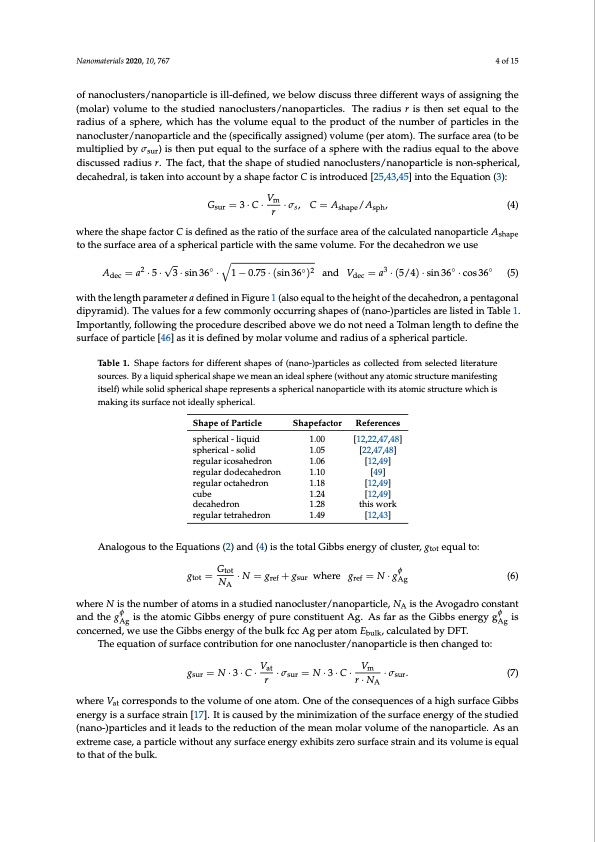
PDF Publication Title:
Text from PDF Page: 004
Nanomaterials 2020, 10, 767 4 of 15 of nanoclusters/nanoparticle is ill-defined, we below discuss three different ways of assigning the (molar) volume to the studied nanoclusters/nanoparticles. The radius r is then set equal to the radius of a sphere, which has the volume equal to the product of the number of particles in the nanocluster/nanoparticle and the (specifically assigned) volume (per atom). The surface area (to be multiplied by σsur) is then put equal to the surface of a sphere with the radius equal to the above discussed radius r. The fact, that the shape of studied nanoclusters/nanoparticle is non-spherical, decahedral, is taken into account by a shape factor C is introduced [25,43,45] into the Equation (3): Gsur=3·C·Vm·σs, C=Ashape/Asph, (4) r where the shape factor C is defined as the ratio of the surface area of the calculated nanoparticle Ashape to the surface area of a spherical particle with the same volume. For the decahedron we use Adec = a2 ·5·√3·sin36◦ ·1−0.75·(sin36◦)2 and Vdec = a3 ·(5/4)·sin36◦ ·cos36◦ (5) with the length parameter a defined in Figure 1 (also equal to the height of the decahedron, a pentagonal dipyramid). The values for a few commonly occurring shapes of (nano-)particles are listed in Table 1. Importantly, following the procedure described above we do not need a Tolman length to define the surface of particle [46] as it is defined by molar volume and radius of a spherical particle. Table 1. Shape factors for different shapes of (nano-)particles as collected from selected literature sources. By a liquid spherical shape we mean an ideal sphere (without any atomic structure manifesting itself) while solid spherical shape represents a spherical nanoparticle with its atomic structure which is making its surface not ideally spherical. Shape of Particle Shapefactor spherical - liquid 1.00 spherical - solid 1.05 regular icosahedron 1.06 regular dodecahedron 1.10 regular octahedron 1.18 cube 1.24 decahedron 1.28 regular tetrahedron 1.49 [12,43] Analogous to the Equations (2) and (4) is the total Gibbs energy of cluster, gtot equal to: gtot = Gtot ·N = gref +gsur where gref = N·gφ (6) where N is the number of atoms in a studied nanocluster/nanoparticle, NA is the Avogadro constant and the gφ is the atomic Gibbs energy of pure constituent Ag. As far as the Gibbs energy gφ is Ag concerned, we use the Gibbs energy of the bulk fcc Ag per atom Ebulk, calculated by DFT. Ag The equation of surface contribution for one nanocluster/nanoparticle is then changed to: gsur = N·3·C· Vat ·σsur = N·3·C· Vm ·σsur. (7) where Vat corresponds to the volume of one atom. One of the consequences of a high surface Gibbs energy is a surface strain [17]. It is caused by the minimization of the surface energy of the studied (nano-)particles and it leads to the reduction of the mean molar volume of the nanoparticle. As an extreme case, a particle without any surface energy exhibits zero surface strain and its volume is equal to that of the bulk. r r · NA References [12,22,47,48] [22,47,48] [12,49] [49] [12,49] [12,49] this work NA AgPDF Image | Quantum-Mechanical of the Energetics of Silver Decahedron Nanoparticles

PDF Search Title:
Quantum-Mechanical of the Energetics of Silver Decahedron NanoparticlesOriginal File Name Searched:
nanomaterials-10-00767-v2.pdfDIY PDF Search: Google It | Yahoo | Bing
Turbine and System Plans CAD CAM: Special for this month, any plans are $10,000 for complete Cad/Cam blueprints. License is for one build. Try before you buy a production license. More Info
Waste Heat Power Technology: Organic Rankine Cycle uses waste heat to make electricity, shaft horsepower and cooling. More Info
All Turbine and System Products: Infinity Turbine ORD systems, turbine generator sets, build plans and more to use your waste heat from 30C to 100C. More Info
CO2 Phase Change Demonstrator: CO2 goes supercritical at 30 C. This is a experimental platform which you can use to demonstrate phase change with low heat. Includes integration area for small CO2 turbine, static generator, and more. This can also be used for a GTL Gas to Liquids experimental platform. More Info
Introducing the Infinity Turbine Products Infinity Turbine develops and builds systems for making power from waste heat. It also is working on innovative strategies for storing, making, and deploying energy. More Info
Need Strategy? Use our Consulting and analyst services Infinity Turbine LLC is pleased to announce its consulting and analyst services. We have worked in the renewable energy industry as a researcher, developing sales and markets, along with may inventions and innovations. More Info
Made in USA with Global Energy Millennial Web Engine These pages were made with the Global Energy Web PDF Engine using Filemaker (Claris) software.
Infinity Turbine Developing Spinning Disc Reactor SDR or Spinning Disc Reactors reduce processing time for liquid production of Silver Nanoparticles.
| CONTACT TEL: 608-238-6001 Email: greg@infinityturbine.com | RSS | AMP |